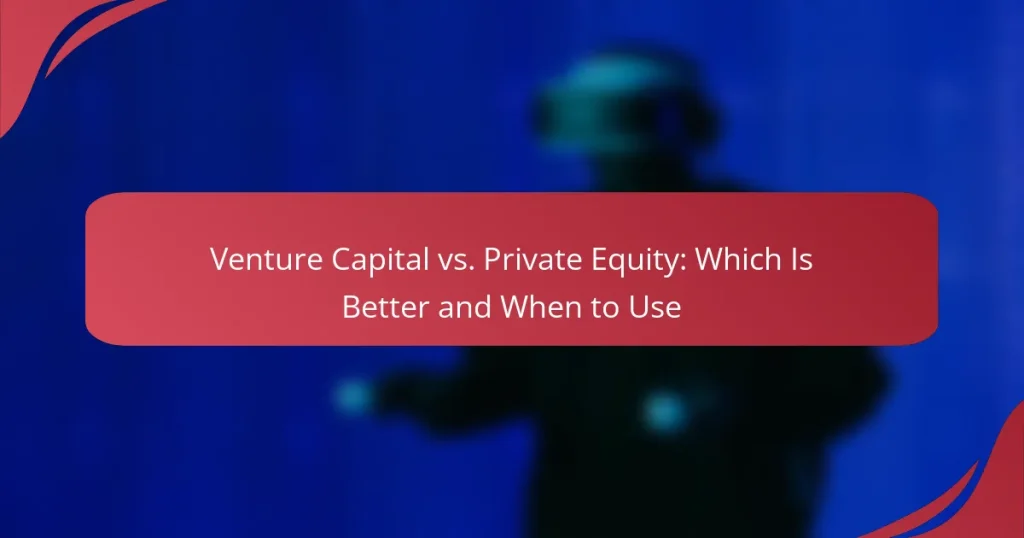Understanding the various funding sources available for tech startups is crucial for entrepreneurs seeking to launch and grow their businesses. From venture capital firms and angel investors to crowdfunding platforms and government grants, each option presents unique advantages and challenges. Evaluating these sources in relation to a startup’s specific goals and development stage can significantly impact its success in the competitive tech landscape.
International Funding Sources: Grants, Investors and Partnerships
Traditional Banks vs. Online Lenders: Loan Terms, Approval Speed and Fees
Crowdfunding: Platforms, Strategies and Success Metrics
Incubators: Support Services, Funding Opportunities and Networking
Venture Capital vs. Private Equity: Which Is Better and When to Use
Bootstrapping: Advantages, Disadvantages and Financial Control
What are the best funding sources for tech startups in the US?
The best funding sources for tech startups in the US include venture capital firms, angel investors, crowdfunding platforms, government grants, and accelerators or incubators. Each source has its own advantages and considerations, making it essential for entrepreneurs to evaluate which option aligns best with their business goals and stage of development.
Venture capital firms
Venture capital (VC) firms provide significant funding to startups in exchange for equity. They typically invest in businesses with high growth potential and a scalable model, often in the range of hundreds of thousands to millions of dollars. Startups seeking VC funding must demonstrate a strong business plan and a capable management team.
When approaching VC firms, prepare a compelling pitch deck that outlines your market opportunity, competitive landscape, and financial projections. Be aware that VCs often seek a return on investment within a few years, so having a clear exit strategy is crucial.
Angel investors
Angel investors are affluent individuals who provide capital to startups, usually in exchange for convertible debt or ownership equity. Their investments can range from tens of thousands to a few hundred thousand dollars. Unlike VCs, angel investors often take a more personal interest in the startup and may offer mentorship alongside funding.
To attract angel investors, focus on building relationships within your industry and networking at startup events. Present a clear vision and demonstrate traction to increase your chances of securing their support.
Crowdfunding platforms
Crowdfunding platforms allow startups to raise small amounts of money from a large number of people, typically via online platforms. Popular options include Kickstarter, Indiegogo, and GoFundMe. This method can generate funding in the range of thousands to millions of dollars, depending on the campaign’s appeal and marketing efforts.
Successful crowdfunding campaigns require a well-crafted pitch, engaging visuals, and a marketing strategy to reach potential backers. Offering attractive rewards or equity can incentivize contributions, but be mindful of the platform’s fees and regulations regarding equity crowdfunding.
Government grants
Government grants provide non-repayable funds to startups for specific projects, often aimed at innovation or research and development. In the US, programs like the Small Business Innovation Research (SBIR) and Small Business Technology Transfer (STTR) offer grants that can range from tens of thousands to millions of dollars.
Applying for government grants typically involves a rigorous application process, including detailed project proposals and compliance with specific guidelines. Ensure your project aligns with the grant’s objectives and be prepared to demonstrate its potential impact.
Accelerators and incubators
Accelerators and incubators support startups through mentorship, resources, and sometimes funding in exchange for equity. Accelerators usually run fixed-term programs that culminate in a demo day, while incubators may offer longer-term support. Funding can vary widely, often ranging from tens of thousands to several hundred thousand dollars.
Joining an accelerator or incubator can provide invaluable networking opportunities and access to industry experts. Research programs that align with your startup’s focus and prepare a strong application to maximize your chances of acceptance.
How do venture capital firms evaluate tech startups?
Venture capital firms evaluate tech startups primarily by assessing their market potential, team experience, and product viability. These factors help investors determine the likelihood of a startup’s success and its potential return on investment.
Market potential analysis
Market potential analysis involves examining the size and growth prospects of the target market. Investors look for startups that operate in large, expanding markets with significant demand for their products or services.
Key metrics include total addressable market (TAM) and market growth rates. Startups should clearly articulate their market strategy and how they plan to capture market share, often using data to support their claims.
Team experience assessment
The experience and background of the startup’s team are critical in venture capital evaluations. Investors prefer teams with a proven track record in relevant industries, as well as complementary skills among team members.
Startups should highlight the expertise of their founders and key personnel, showcasing past successes and relevant experiences. A strong team can significantly enhance investor confidence in the startup’s ability to execute its vision.
Product viability review
Product viability review focuses on the feasibility and market readiness of the startup’s offering. Investors assess whether the product solves a real problem and if there is a demand for it in the market.
This review often includes examining prototypes, customer feedback, and competitive analysis. Startups should be prepared to demonstrate their product’s unique value proposition and how it stands out from competitors.
What are the advantages of crowdfunding for tech startups?
Crowdfunding offers tech startups a unique way to raise capital while engaging directly with potential customers. It allows entrepreneurs to gather funds from a large number of people, often through online platforms, which can lead to increased visibility and support for their projects.
Access to a large audience
Crowdfunding platforms provide tech startups with access to a vast pool of potential investors and customers. This exposure can significantly enhance brand awareness and attract interest from individuals who may not be reachable through traditional funding methods.
By presenting their projects on popular crowdfunding sites, startups can connect with thousands of backers who are interested in innovative technology. This large audience can lead to substantial funding opportunities, often exceeding initial expectations.
Market validation opportunity
Launching a crowdfunding campaign allows tech startups to test their product ideas in the market before fully committing to production. By gauging interest and receiving feedback from backers, entrepreneurs can validate their concepts and make necessary adjustments based on real-world input.
This validation process can be crucial for attracting further investment, as it demonstrates demand and reduces perceived risk for future investors. Successful campaigns often serve as proof of concept, showcasing that there is a viable market for the product.
Minimal upfront costs
Crowdfunding typically requires lower upfront costs compared to traditional funding routes. Startups can launch a campaign with minimal financial investment, often just the cost of creating a compelling presentation and marketing materials.
This approach allows entrepreneurs to retain more equity in their companies while avoiding the burdensome debt associated with loans. However, it’s important to budget for potential platform fees, which can range from 5% to 10% of the funds raised, depending on the crowdfunding service used.
What criteria should tech startups consider when choosing funding sources?
Tech startups should evaluate several key criteria when selecting funding sources, including the amount of funding needed, the potential impact on equity dilution, and how funding may affect control and decision-making within the company. Each of these factors can significantly influence the startup’s growth trajectory and operational flexibility.
Funding amount needed
Determining the funding amount needed is crucial for tech startups. Startups should assess their current financial situation, projected expenses, and growth plans to establish a realistic funding target. Typically, funding requirements can range from low tens of thousands to several million dollars, depending on the stage of the startup and its operational needs.
It’s beneficial to create a detailed budget that outlines expected costs, including product development, marketing, and staffing. This budget can guide discussions with potential investors and help clarify the necessary funding level.
Equity dilution impact
Equity dilution occurs when a startup raises funds by issuing new shares, which can reduce the ownership percentage of existing shareholders. Startups must carefully consider how much equity they are willing to give up in exchange for funding. Dilution can vary widely, with early-stage rounds often resulting in single-digit to low double-digit percentage dilution.
To mitigate excessive dilution, startups can explore various funding options such as convertible notes or SAFE (Simple Agreement for Future Equity) agreements, which may delay dilution until a later funding round. Understanding the long-term implications of dilution is essential for maintaining control and maximizing future funding potential.
Control and decision-making
Control and decision-making are critical aspects to consider when choosing funding sources. Different funding options come with varying degrees of influence over business operations. For instance, venture capitalists often seek significant control and may require board seats, while angel investors may take a more hands-off approach.
Startups should evaluate how much control they are willing to relinquish in exchange for funding. Establishing clear agreements regarding decision-making authority can help prevent conflicts down the line. It’s advisable to prioritize funding sources that align with the startup’s vision and operational style to ensure a harmonious working relationship.
How can tech startups prepare for investor pitches?
Tech startups can prepare for investor pitches by developing a clear narrative, a comprehensive business plan, and a robust financial model. These elements help convey the startup’s vision, operational strategy, and financial viability to potential investors.
Crafting a compelling narrative
A compelling narrative is essential for engaging investors and making your startup memorable. Start by clearly articulating your mission, the problem you are solving, and how your solution stands out in the market.
Use storytelling techniques to connect emotionally with your audience. Highlight customer testimonials or success stories to illustrate the impact of your product or service.
Creating a detailed business plan
A detailed business plan outlines your startup’s strategy, market analysis, and operational structure. Include sections on your target market, competitive landscape, and marketing strategies to demonstrate thorough research and planning.
Make sure to present clear milestones and timelines for achieving your goals. This helps investors understand your roadmap and the potential for growth.
Developing a financial model
A robust financial model is crucial for showcasing your startup’s financial health and projections. Include key metrics such as revenue forecasts, expenses, and cash flow analysis to provide a comprehensive view of your financial outlook.
Consider using a three to five-year projection period, which is standard in the industry. Be prepared to discuss assumptions behind your numbers and how you plan to achieve them, as this demonstrates credibility and foresight.
What are common mistakes tech startups make when seeking funding?
Tech startups often make several key mistakes when seeking funding, which can hinder their chances of success. Common pitfalls include insufficient market research, unclear value propositions, and lack of a solid business plan.
Insufficient market research
Many startups fail to conduct thorough market research before seeking funding. Understanding the target market, customer needs, and competitive landscape is crucial. Without this knowledge, startups may struggle to convince investors of their potential for success.
To avoid this mistake, startups should invest time in gathering data on market trends, customer demographics, and competitor analysis. This information can help refine their business model and strengthen their pitch to investors.
Unclear value proposition
A clear and compelling value proposition is essential for attracting investors. Startups often struggle to articulate what makes their product or service unique and why it matters to customers. This lack of clarity can lead to confusion and disinterest from potential backers.
Startups should focus on defining their value proposition in simple terms, highlighting the problem they solve and the benefits they offer. Practicing the pitch with mentors or peers can help refine this message before approaching investors.
Lack of a solid business plan
A comprehensive business plan is vital for securing funding. Startups that present vague or incomplete plans may find it difficult to gain investor confidence. A solid business plan should outline the business model, revenue streams, marketing strategy, and financial projections.
Startups should ensure their business plan is well-structured and includes realistic financial forecasts. Regularly updating the plan based on market feedback can also demonstrate adaptability and foresight to potential investors.






